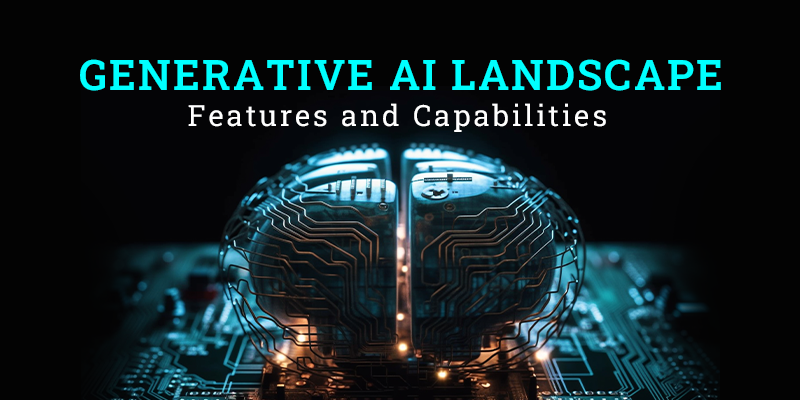Generative AI Landscape – Features and Capabilities

Generative AI Landscape
Generative Artificial Intelligence (AI) is a transformative domain within AI, enabling machines to create original content across modalities such as text, images, audio, and video. This technology has grown exponentially, fuelled by innovations from leading organizations like OpenAI, DeepMind, Meta, Anthropic, and Stability AI. These organizations, alongside open platforms like Hugging Face, GitHub, and Kaggle, are shaping the field by providing state-of-the-art models, datasets, and platforms for research and application development.
The rapid adoption of generative AI has made it essential to understand the landscape of tools and technologies available for diverse use cases, ranging from conversational AI and content creation to code generation and multimedia design. Each model brings unique capabilities, limitations, and ethical implications, making comparative analysis crucial for informed decision-making and responsible deployment.
Features and Capabilities
This blog explores and compares leading generative AI models, offering insights into:
- Model Capabilities: The functionalities and strengths of generative models, spanning text-based AI (e.g., GPT-4, Claude) to image generation systems (e.g., DALL·E, Stable Diffusion) and beyond.
- Inputs and Outputs Supported: How each model processes input data and produces outputs, showcasing their usability across applications.
- Cost Structures and Free-Tier Limits: An overview of pricing models and accessibility, particularly highlighting free and open-source options versus subscription-based services.
- Use Cases Practical applications across industries, such as enhancing productivity, fostering creativity, and advancing research.
- Ethical Considerations: Addressing the challenges of deploying AI responsibly, including managing biases, ensuring data privacy, and mitigating misuse.
The accompanying matrix distils this information into a comparative format, facilitating an at-a-glance understanding of the key attributes, strengths, and considerations of each model and platform. Whether you’re a researcher exploring state-of-the-art capabilities, a developer integrating AI into products, or an organization leveraging AI for innovation, this guide serves as a foundational resource for navigating the generative AI ecosystem.
To assist you in understanding the landscape of generative AI models across various modalities—text, image, audio, and video—here is a comparative matrix highlighting key models from leading organizations. This matrix includes details on model capabilities, supported inputs and outputs, cost structures, use cases, and ethical considerations.
Comparative Matrix of Generative AI Models
| Organization | Model Name | Modality | Inputs | Outputs | Cost Structure | Use Cases | Ethical Considerations |
| OpenAI | GPT-4 | Text | Text | Text | Subscription-based; free tier with limitations | Conversational AI, content creation, coding assistance | Bias mitigation, misuse prevention |
| OpenAI | DALL·E 3 | Image | Text | Image | Subscription-based; free tier with limitations | Image generation from descriptions | Content moderation, copyright issues |
| DeepMind | Gemini | Text | Text | Text | Proprietary; integrated into Google services | Search enhancement, summarization | Data privacy, misinformation risks |
| Meta | LLaMA 3.1 | Text | Text | Text | Open source; free access | Research, application development | Responsible use policies, misuse prevention |
| Meta | Make-A-Scene | Image | Text, Sketch | Image | Open source; free access | Creative design, visual content creation | Bias in image generation, content moderation |
| Meta | Voicebox | Audio | Text, Audio | Audio | Proprietary; likely integrated with Meta platforms | Speech synthesis, audio editing | Misuse prevention (e.g., voice cloning) |
| Anthropic | Claude 3.5 | Text | Text | Text | Subscription-based; free tier with limitations | Conversational AI, summarization, content creation | Safety measures, ethical AI alignment |
| Stability AI | Stable Diffusion | Image | Text, Image | Image | Open source; free access | Art generation, design | Content moderation, misuse prevention |
| Hugging Face | BLOOM | Text | Text | Text | Open source; free access | Model hosting, research | Model bias, ethical use |
| GitHub | Copilot | Code | Code | Code | Subscription-based; free tier with limitations | Code assistance, development | Code quality, dependency management |
| Kaggle | Various | Data | Data | Data | Free access | Data analysis, competitions | Data privacy, ethical data use |
Key Insights:
Model Capabilities: Generative AI models have advanced to support multiple modalities, including text, image, audio, and video generation. Organizations like OpenAI and Meta offer models that cater to diverse applications, from content creation to code assistance.
Inputs and Outputs: Most models accept text inputs and generate outputs corresponding to their modality. For instance, DALL·E 3 generates images from textual descriptions, while GPT-4 produces text-based responses.
Cost Structures and Free-Tier Limits: Organizations adopt varied pricing models. OpenAI and Anthropic offer subscription-based access with free tiers that have usage limitations. In contrast, Meta and Stability AI provide open-source models accessible at no cost, promoting research and development.
Use Cases: These models serve a wide array of applications, including content generation, code assistance, language translation, and creative design. Their versatility makes them valuable across industries such as technology, media, and education.
Ethical Considerations: The deployment of generative AI models raises ethical concerns, including bias mitigation, content moderation, data privacy, and the prevention of misuse. Organizations are implementing measures to address these issues, such as responsible use policies and safety protocols.
What Next?
This analysis aims to provide a clear and detailed comparison of the major generative AI players and their offerings. Exploring these dimensions, equips developers, researchers, and organizations with actionable insights to choose the most suitable models for their projects while aligning with ethical AI principles.
As the Gen AI field evolves, staying informed about advancements and ethical guidelines is crucial for responsible and effective utilization of these technologies.
At REVA Academy for Corporate Excellence, RACE, REVA University, specialised research groups are actively involved in building multiple Gen AI-based projects sponsored by various organizations. Check out here to learn more about our bespoke programs in Artificial Intelligence.
Visit our website race. reva.edu.in or Call: +91 80693 78092 or write to us: race@reva.edu.in



